originally published: 08/01/2024
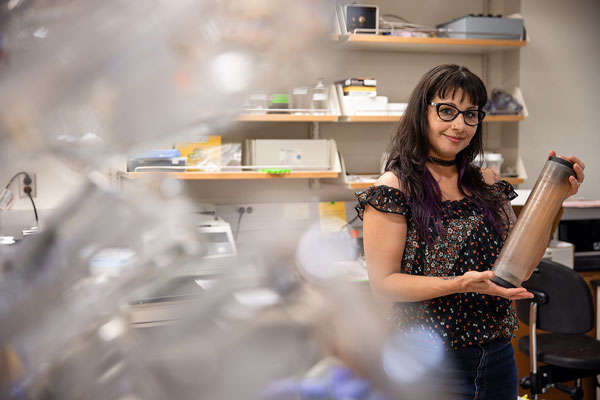
Lauren Seyler, an assistant Biology professor, poses in her lab with a sample of sediment collected from the sea floor of the Atacama Trench off the coast of Chile. Seyler, who also dabbles in astrobiology, was the co-principal scientist on an expedition with the Schmidt Ocean Institute. Photo by Susan Allen/Stockton University
(GALLOWAY, NJ) -- Lauren Seyler believes the search for alien life in the universe begins much closer to home — on the bottom of the ocean.
The Stockton University assistant Biology professor — who also dabbles in astrobiology — spent three weeks this summer off the coast of Chile as the co-principal scientist on a research expedition studying the ocean floor near the Atacama Trench, at depths of more than 9,300 feet.
The goal? Locate areas called seeps where chemical energy, such as methane gas, is released. Then, using a remote-operated vehicle (ROV) take sediment samples and video and observe how that gas creates life where light, the most common source of energy on Earth, can’t possibly reach because of the depth.
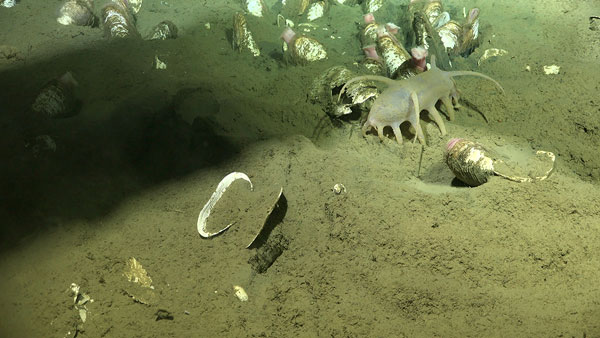
A sea pig walks among some clams found at the bottom of the ocean floor near the methane seep off the coast of Chile. The seeps are the deepest and furthest north found off the coast of the South American country. Photo by Schmidt Ocean Institute
“Methane is a great source of energy,” said Seyler, who has taught at Stockton since 2020. “Sources of chemical energy are truly alien. It’s such an interesting way of looking at life as a concept because it’s so different from what we see in our day-to-day lives. We are here where the sun is shining and there’s oxygen and there’s plants. But it’s a very, very different world down there, and that’s what I love about it. It’s just so fascinating.”
Astrobiology is a fairly recent field of study that only dates back to the 1950s and 1960s and focuses on how life originated on Earth and how life could form on other worlds. It’s an umbrella term that incorporates chemistry, physics, geology, biology and oceanography.
“We are trying to figure out how life originated on Earth from geochemistry,” said Seyler, who will teach a general studies class at Stockton in Astrobiology in the fall semester. “How did life develop from chemistry into cells and multicellular life. And how does that relate to the history of the planet as a whole?”
Often astrobiologists’ research overlaps with oceanographers since the search for life on other planets is primarily the search for water.
“We know that life on Earth requires water. We don’t have any examples of life that doesn’t require water in some form,” she said. “There are other ocean worlds in our solar system, including Europa, a moon of Jupiter, and Enceladus, a moon of Saturn, that may be home to life that uses chemical sources of energy as opposed to sunlight.”
And this expedition allowed Seyler and other scientists to study how an ecosystem dependent on chemical energy, like methane, creates microbes and other life.
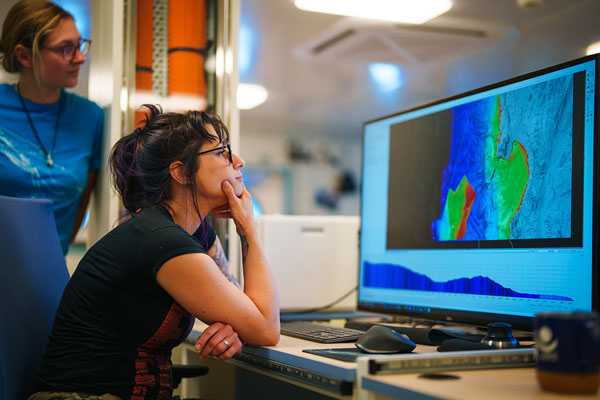
Stockton Assistant Biology Professor Lauren Seyler looks over some ocean-floor mapping data off the coast of Chile in an effort to locate methane seeps at the bottom of the Atacama Trench. Seyler spent 20- to 22-hour days looking for the seeps. Photo by Schmidt Ocean Institute
After more than three years of planning, Seyler co-led the expedition onboard a vessel owned by the Schmidt Ocean Institute, a nonprofit whose goal is to advance innovative oceanographic research through technological advancement, collaborative research, outreach and education.
“We were really fortunate to work with Schmidt. The ship, the Falkor (too), is incredible. It has a huge lab space, multimedia room, computers and monitors in every room,” she said. “A lounge, karaoke room, chefs who prepare food at regular meal times. They really thought of everything to make this as comfortable as possible for the scientific party. It was a combination floating hotel and laboratory.”
The expedition also had a high-speed internet connection that allowed the scientists to livestream dives and take part in a webcast with NASA’s Astrobiology Program about their research. But even with all of the latest technology and equipment, the discovery of the methane seeps “ended up being a fortunate accident” and was not without numerous challenges, Seyler said.
“Originally we had planned to look at more shallower sites closer to the Chilean coast, but our permit wouldn’t allow us to go within 12 nautical miles of the coast,” she said.
Also, a delay in receiving the permit condensed the expedition’s time from two weeks to only six days, “which was insane considering all the things that we had planned to do,” she said.
The expedition had some ocean-floor mapping data to determine where to look. They knew that naturally occurring methane seeps often formed in locations like the Atacama Trench, where two tectonic plates collide and one is pressed under the other, forming ridges, cliffs and fissures. But Seyler admits they “got very lucky.”
The ship used multibeam sonar to search the ocean floor for the best possible locations. Then an ROV traversed to the bottom and very, very slowly (less than 2 mph) searched about 300 feet ahead for ridges and outcroppings of rock where methane might bubble up.
“It’s like climbing up a mountain with one flashlight. You have a very narrow field of view,” she said.
And with the compressed schedule and limited dive time, Seyler and the other scientists worked 20- to 22-hour days, mostly staring at a computer screen.
“Get up, eat breakfast and then just science, all day,” she said. “You eat, sleep and breathe the project. I thrive in those kinds of conditions, and it was great to just be totally immersed for this period of time.”
But there were no guarantees they would find anything on a mostly barren sea floor.
Advertise with New Jersey Stage for $50-$100 per month, click here for info
“When you go down to the bottom of the ocean, you are going to see something cool no matter what, but we didn’t know if we were going to find any seeps,” she said. “It’s just send the ROV down and just follow it for hours in the dark waiting to see something.”
Finally on day four, the ROV found what Seyler called “a little oasis on the bottom of the sea floor” — a methane seep that produced all kinds of sea life, including ashy, grey- and black-colored mats of bacteria, 6- to 7-inch clams, tube worms, and a species of sea cucumber called a sea pig. The seeps are the deepest and furthest north found off the coast of Chile.
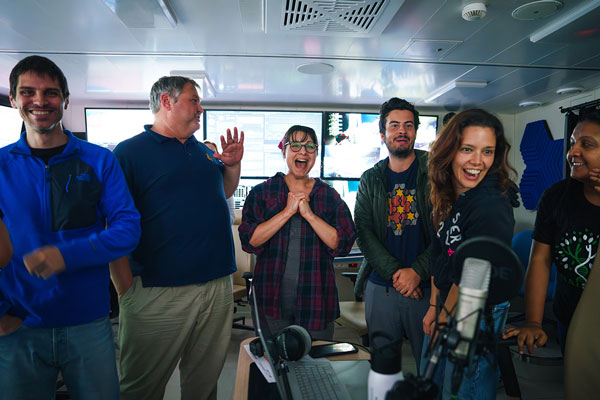
Seyler, center, and other scientists celebrate after discovering a methane seep on day four of the expedition off the coast of Chile. Photo by Schmidt Ocean Institute
“Habitats like methane seeps prove that chemical energy can sustain more than just microbes. You could have larger organisms, like animals, sustained off this energy as well, which makes the search for life on other worlds even more exciting,” she said.
Seyler said the ROV took “a ton” of sediment samples that she brought back to Stockton. She plans to work with students to extract DNA from the microbial communities in the sediment, sequence it and categorize it for further study. She’s also working with geologists at Centro de Astrobiologia in Spain and astrobiologists at the Florida Institute of Technology interested in the compounds the microbes might be making.
“We are so fortunate that Dr. Seyler was able to lead this exciting research expedition,” said Amanda Norvell, the dean of Stockton’s School of Natural Sciences and Mathematics. “This opportunity not only helps her contribute to our understanding of the big questions about how life could evolve, but she is able to bring that science back into the labs and classrooms here at Stockton so that our students can learn and be a part of this fundamental work.”
While the expedition was the longest time she had been away from her two young children, Seyler, 40, added that it was a formative experience for her as a scientist.
“I had never led an expedition like this before,” she said. “I really learned a lot about myself and what I’m capable of. I gained a lot more confidence in myself and my ability to work under pressure, work long hours, work with all kinds of uncertainty.
“But what I’ve always been interested in as an oceanographer is what’s at the bottom. What’s in the mud. I love looking at the bottom of the ocean because we know so little about it.”
Stockton University is ranked among the top public universities in the nation. Our more than 9,000 students can choose to live and learn on the 1,600-acre wooded main campus in the Pinelands National Reserve in South Jersey and at our coastal residential campus just steps from the beach and Boardwalk in Atlantic City. The university offers more than 160 undergraduate and graduate programs.
FEATURED EVENTS
To narrow results by date, categories,
or region of New Jersey click here.

Dan Buettner
Tuesday, September 17, 2024 @ 6:00pm
Grunin Center
1 College Drive, Toms River, NJ 08754
category: community
Click here for full description
A Conversation with Stephanie Ramos
Wednesday, September 25, 2024 @ 6:00pm
Grunin Center
1 College Drive, Toms River, NJ 08754
category: community
Click here for full description
The Price Is Right Live!
Saturday, September 28, 2024 @ 8:00pm
Bergen Performing Arts Center (bergenPAC)
30 North Van Brunt Street, Englewood, NJ 07631
category: community
Click here for full description
Click here for more events
Listings are available for $10 and included with our banner ad packages.
Click here for more info.
EVENT PREVIEWS
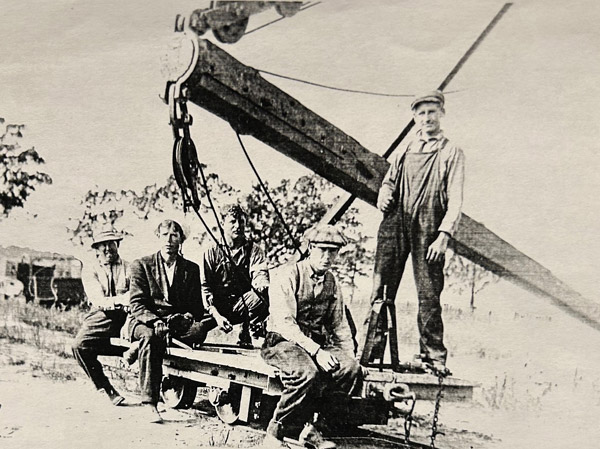
Probe a Landmark's Mysterious Past at the Ocean County Library Tuckerton Branch
(TUCKERTON, NJ) -- A radio tower in Tuckerton was among the world’s tallest structures when it was built in 1912. It soon became a lightning rod of international intrigue. Discover its hidden history during "WSC Calling: The Tuckerton Wireless Tower" at the Ocean County Library Tuckerton Branch on Monday, September 16, 2024. The event begins at 7:00pm.
ON-GOING EVENTS

Cape May MAC presents "The War Comes Home to America: U-boats off the Mid-Atlantic"
(CAPE MAY, NJ) -- How the United States, Cape May County, and American Admiral Ernest J. King dealt with the German U-boat menace, and the story of Germany's warfare off the coast of Cape May during World War II, is the subject of this year's lecture in the Cape May MAC (Museum+Arts+Culture) annual Lessons of History Distinguished Lecture Series.











